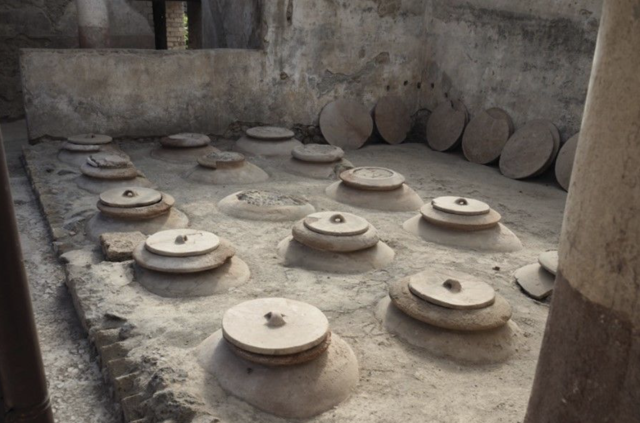This website uses cookies so that we can provide you with the best user experience possible. Cookie information is stored in your browser and performs functions such as recognising you when you return to our website and helping our team to understand which sections of the website you find most interesting and useful.
What can modern producers learn from Roman wine?
Archaeologists researching ancient clay jars have discovered exactly how Roman wine smelt, tasted and even could have looked.

The study included the assessment of large clay pots that were called dolia, and were manufactured for fermenting, storing and ageing wine.
Published in the journal Antiquity and called Making wine in earthenware vessels: a comparative approach to Roman vinification, the research compares modern and ancient winemaking techniques, and how contemporary producers are now reviving ancient methods in the hope of continuing traditional wine practices and flavours.
Dr Dimitri Van Limbergen from the University of Ghent and Paulina Komar from the University of Warsaw compared Roman dolia wine vessels with Georgian earthenware pots called qveri that uses a similar fermentation method to the Roman wine. Therefore, the researchers believed that a comparison between the two processes was worth investigating, illuminating the similarities between ancient and modern methods of production on the flavour of wine.
Containers
In contemporary winemaking, earthenware vessels have normally been replaced by wooden, concrete and steel containers. But the use of large ceramic containers has a long-standing tradition in the Mediterranean, it said. While other cultures have continued to use earthenware until the nineteenth century, including in Chile and Peru, it is particularly noteworthy that the qveri in Georgia have continued into the modern era, and the production technique was granted UNESCO World Intangible Cultural Heritage status in 2013.
Van Limbergen said: “The value of identifying, often unexpected, parallels between modern and ancient winemaking lies in both debunking the alleged amateurish nature of Roman winemaking and uncovering common traits in millennia-old vinification procedures.”
“No study has yet scrutinised the role of these earthenware vessels in Roman winemaking and their impact on the look, smell and taste of ancient wines”, state the authors.
According to the study, the shape of the vessel was important, as the narrow base of the fermentation vessel prevented grape solids from having too much contact with the ageing wing, increasing its longevity and giving it a “beautiful orange colour, prized by the ancient world”.
When the doli were buried in the ground, temperature and pH levels could be controlled, which encouraged the formation of surface yeasts and also a chemical called sotolon that gave the “wine a slightly spicy flavour with aromas of toasted bread and walnuts”.
The clay vessels were porous, so unlike modern metal containers there was oxidation during the fermentation process, which allowed for “controlled oxidation concentrates colour and creates pleasant grassy, nutty and dried fruit-like flavours.”
Artisanal
Unlike common perceptions of Roman winemaking being an amateurish pursuit, the researchers found that Romans were aware of the variety of techniques that could be used to alter the qualities of wine, including how changing the shape, size and clay of the dolia – as well as how it is stored – would result in a different end product.
The researchers said: “Far from being mundane storage vessels, dolia were precisely engineered containers whose composition, size and shape all contributed to the successful production of diverse wines with specific organoleptic characteristics.” They also highlighted that the vessels were highly valued items made by skilled artisans using specially selected clay mixtures.
Wine was embedded into Roman society and wine cellars have been found all over Italy, including at the Villa Regina and Pisanella farmhouses near Pompeii and the so-called Villa of Augustus at Somma Vesuviana.
The research considered the “considerable genetic affinity is also apparent between Roman grape cultivars and Georgian (and Caucasian) Vitis grapevines” and that “evidence strengthens the case for a millennia-long transfer of cultivars and techniques from east to west, perhaps brought to Italy through Phoenician and Etruscan contacts”.
Georgian wine
The research found that “the basic course of vinification in both qvevri and dolia, as revealed by modern anthropological observations and ancient sources, is remarkably similar”.
In modern Georgian winemaking, primary fermentation in qvevri lasts two to three weeks, during which the jars remain open. When fermentation starts, the grape skins and solids rise to the surface because of the production of carbon dioxide, forming a ‘cap’ over the fermenting wine.
In this phase, the skins and solids are regularly punched down to keep them wet. After two to three weeks, the vessels are sealed with a stone or wooden lid and covered with earth, remaining so for six to nine months.
The wine is then bottled for consumption or transferred into clean qvevri for ageing in an operation similar to Roman winemaking. It also suggests that Roman winemakers not only used similar equipment and procedures but were also aiming to make wines akin in character to those that are now produced in modern-day Georgia. Ancient texts give ample evidence for the presence of surface yeasts in Greek and Roman wines.
The study said: “There is little doubt that, just as with qvevri, ancient wines stored in dolia were regularly subjected to flor yeasts.”
Researchers will now explore the similarities between ancient and modern vessels in further detail, including understanding how the pottery contributes to a “range of sensory properties” to wine through their porosity and clay composition, which are not found in modern concrete or stainless steel tanks.
It said: “A new generation of modern winemakers is experimenting with ceramic vessel vinification, and a systematic scientific study of their efforts would be of great ethnoarchaeological value.
“We also need DNA studies of yeast varieties, targeted in particular at the detection of flor yeasts, to assess securely their importance in Roman and Georgian winemaking.”

